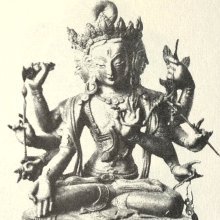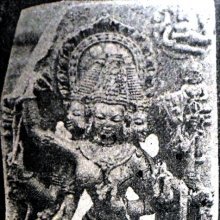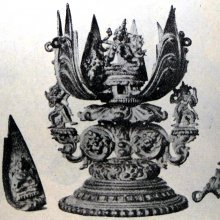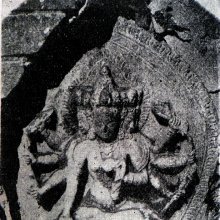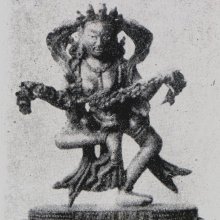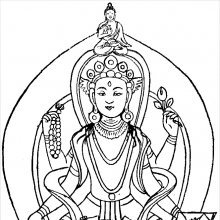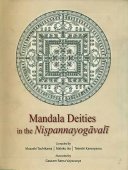Vajratara, Vajratārā, Vajra-tara: 5 definitions
Introduction:
Vajratara means something in Buddhism, Pali, Hinduism, Sanskrit. If you want to know the exact meaning, history, etymology or English translation of this term then check out the descriptions on this page. Add your comment or reference to a book if you want to contribute to this summary article.
Images (photo gallery)
(+2 more images available)
In Buddhism
Tibetan Buddhism (Vajrayana or tantric Buddhism)
Source: archive.org: The Indian Buddhist Iconography1) Vajratārā (वज्रतारा) refers to one of the various emanations of Ratnasambhava, as mentioned in the 5th-century Sādhanamālā (a collection of sādhana texts that contain detailed instructions for rituals).—Her Colour is golden yellow; she has four faces and eight arms.
Vajratārā is described in the Niṣpannayogāvalī (and 11th-century Buddhist work) as follows:—
“Goddess Vajratārā is of golden yellow colour. She is four- faced. The principal face is golden in colour, the right is white, the one behind is blue and the left red. She has eight arms. In her four right hands she shows the vajra, the noose, the arrow and the conch. In the four left she has the yellow night lotus, the bow, the goad, and the raised tarjanī”.
The Dhyāna (meditation instructions) of Vajratārā described in the Sādhanamālā as follows:—
“The worshipper should conceive himself as Vajratārā, who is in the midst of the circle of the Eight Mothers, is eight-armed, four-faced, and decked in all ornaments. Her complexion is like the colour of gold, and she is graceful and resplendent with the auspicious marks of a virgin; she bears the images of the five Dhyāni Buddhas on her crown, and is born of the water of consecration of the vajra and the sun; she is effulgent in her blooming youth, has swaying earrings, sits on the double lotus, and radiates red-hued light; she carries in her right hands the vajra, the noose, the conch and the swift arrow, and in the left the vajrāṅkuśa, the utpala, the bow and the tarjanī. Thus conceiving her as sitting in the vajraparyaṅka attitude (the worshipper) may conquer the three worlds”.
[cf. Vajratārāmaṇḍala and Vajratārāmantra].
2) Vajratārā (वज्रतारा) refers to one of the Goddesses accompanying Sukhāvatī, as described in the Dharmakośasaṃgraha.—[...] “Sukhāvatī Lokeśvara is three-faced, white in colour, and six-armed. One of his right hands is in the act of shooting an arrow, the remaining two have the rosary and the varada pose. In two of his left hands he carries the bow and the lotus, and the third is placed on the thigh of Tārā. He sits in lalitāsana on the lotus, and is surrounded by the goddesses Vajratārā, Viśvatārā, Padmatārā and the like. There is a caitya on the top.”

Tibetan Buddhism includes schools such as Nyingma, Kadampa, Kagyu and Gelug. Their primary canon of literature is divided in two broad categories: The Kangyur, which consists of Buddha’s words, and the Tengyur, which includes commentaries from various sources. Esotericism and tantra techniques (vajrayāna) are collected indepently.
Languages of India and abroad
Sanskrit dictionary
Source: DDSA: The practical Sanskrit-English dictionaryVajratara (वज्रतर).—Name of a kind of very hard cement; Bṛ. S.57.7.
Derivable forms: vajrataraḥ (वज्रतरः).
Vajratara is a Sanskrit compound consisting of the terms vajra and tara (तर).
Source: Cologne Digital Sanskrit Dictionaries: Edgerton Buddhist Hybrid Sanskrit DictionaryVajratārā (वज्रतारा).—name of a form of Tārā: Sādhanamālā 178.10 etc.
Source: Cologne Digital Sanskrit Dictionaries: Monier-Williams Sanskrit-English DictionaryVajratara (वज्रतर):—[=vajra-tara] [from vajra > vaj] m. Name of a kind of very hard cement (= kalka), [Varāha-mihira’s Bṛhat-saṃhitā]
[Sanskrit to German]
Sanskrit, also spelled संस्कृतम् (saṃskṛtam), is an ancient language of India commonly seen as the grandmother of the Indo-European language family (even English!). Closely allied with Prakrit and Pali, Sanskrit is more exhaustive in both grammar and terms and has the most extensive collection of literature in the world, greatly surpassing its sister-languages Greek and Latin.
See also (Relevant definitions)
Starts with: Vajrataramandala, Vajrataramantra.
Full-text: Mandaleya, Gandhatara, Dhupatara, Pushpatara, Dipatara, Vajrataramandala, Vajrataramantra, Vajrasphoti, Padmatara, Vishvatara, Vajraghanta, Shumbha, Vajrankushi, Vajrapashi, Dhanadatara, Sukhavati, Ushnishavijaya.
Relevant text
Search found 7 books and stories containing Vajratara, Vajratārā, Vajra-tara, Vajra-tārā; (plurals include: Vajrataras, Vajratārās, taras, tārās). You can also click to the full overview containing English textual excerpts. Below are direct links for the most relevant articles:
The Indian Buddhist Iconography (by Benoytosh Bhattachacharyya)
Figure 180-183 - Emanations of Ratnasambhava: Vajratārā and Puṣpatārā
Figure 194 - Goddesses of Direction (3): Vajrasphoṭā
Sripura (Archaeological Survey) (by Bikash Chandra Pradhan)
Scultures of Buddhist Goddesses (3): Vajratara < [Chapter 3 - Sculptural Programme]
Bronze-icons < [Chapter 3 - Sculptural Programme]
Guhyagarbha Tantra (with Commentary) (by Gyurme Dorje)
Text 11.17 (Commentary) < [Chapter 11 (Text and Commentary)]
The Skanda Purana (by G. V. Tagare)
Chapter 72 - Victory of Durgā < [Section 2 - Uttarārdha]
Prajnaparamita in Buddhist < [November-December 1931]
Blue Annals (deb-ther sngon-po) (by George N. Roerich)
Chapter 29 - Sonam Gyatso (vi): Spiritual realization < [Book 10 - The Kālacakra]
Related products
